Bill and I really enjoy going to the Upperville Horse and Colt Show. It has many competitions and is always lots of fun. We took the two pictures below while we were watching some of the driving competitions.
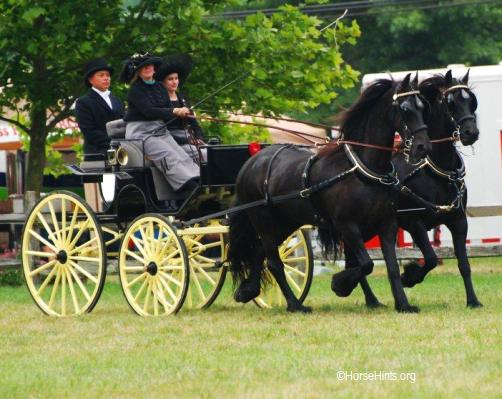 "Upperville is the oldest horse show in the United States. Steeped in tradition, it extends a full seven days, and involves over two thousand horse and rider combinations from young children on ponies to leading Olympic and World Cup riders and horses. ...Held, under The Oaks, in Upperville, Virginia, the showgrounds are located forty miles west of Washington, D.C. in the rolling hills of Virginia's scenic horse country. The magnificent and prestigious Grafton and Salem Farms encompass the show, nestled on both sides of Route 50, between the village of Upperville and town of Middleburg. Long a favorite of horse show competitors and spectators alike, Upperville features full divisions of entries from all corners of the United States and abroad. The show has been voted the Virginia Horse Shows Association Horse Show of the Year and is a designated World Championship Hunter Rider Show. Upperville Horse Show
"Upperville is the oldest horse show in the United States. Steeped in tradition, it extends a full seven days, and involves over two thousand horse and rider combinations from young children on ponies to leading Olympic and World Cup riders and horses. ...Held, under The Oaks, in Upperville, Virginia, the showgrounds are located forty miles west of Washington, D.C. in the rolling hills of Virginia's scenic horse country. The magnificent and prestigious Grafton and Salem Farms encompass the show, nestled on both sides of Route 50, between the village of Upperville and town of Middleburg. Long a favorite of horse show competitors and spectators alike, Upperville features full divisions of entries from all corners of the United States and abroad. The show has been voted the Virginia Horse Shows Association Horse Show of the Year and is a designated World Championship Hunter Rider Show. Upperville Horse Show ![]()
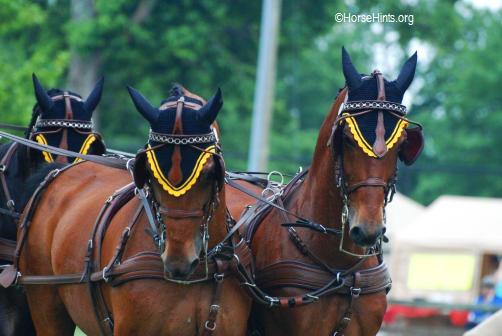 "The Upperville Colt and Horse Show, grand-pere and a grand peer of the nation's horse shows, dates back to 1853. Heretofore, horses - particularly stallions - had been exhibited for prizes at country and state fairs, but it is believed and accepted that the horse show, as a separate entity, was introduced on the American sporting scene at Upperville, Virginia in that year. ..." The History of Upperville
"The Upperville Colt and Horse Show, grand-pere and a grand peer of the nation's horse shows, dates back to 1853. Heretofore, horses - particularly stallions - had been exhibited for prizes at country and state fairs, but it is believed and accepted that the horse show, as a separate entity, was introduced on the American sporting scene at Upperville, Virginia in that year. ..." The History of Upperville ![]()
Carriage horses fall under a larger umbrella of horse which is driving horses. They are horses in harness. The term, in harness, often is used to describe a horse being driven. Horses, ponies, mules and donkeys can be driven. Other non-equids can also be driven such as oxen, llamas, etc. Driving, for equid, is a broad term for hitching equines to a wagon, carriage, cart, sleigh, or other horse-drawn vehicle by means of a harness and working them in this way. It encompasses a wide range of activities from pleasure driving, to harness racing, to farm work, horse shows, and even International combined driving competition.
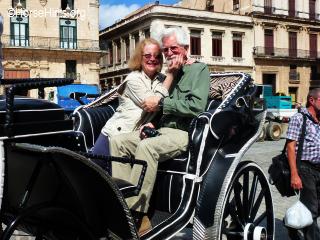 "Have you ever had the experience of riding in a horse drawn carriage? Have you ever wondered about the safety of this experience both in a controlled environment as well as on the public streets or in the public parks? Bill and I have had both experiences. Below you will see an image of us in Cuba enjoying a carriage ride all through Havana. We have also been in horse drawn carriages in more controlled circumstances--privately owned horses and carriages at a friend's home. This thought always crosses our minds because we understand that horses spook and bolt. In fact, we have seen two horse drawn carriages in a run away situation--both ended in unhappy circumstances. One was in the city streets in Washington, DC and the other was at a carriage competition in Kentucky. In both episodes the horses and the carriage occupants were injured.
"Have you ever had the experience of riding in a horse drawn carriage? Have you ever wondered about the safety of this experience both in a controlled environment as well as on the public streets or in the public parks? Bill and I have had both experiences. Below you will see an image of us in Cuba enjoying a carriage ride all through Havana. We have also been in horse drawn carriages in more controlled circumstances--privately owned horses and carriages at a friend's home. This thought always crosses our minds because we understand that horses spook and bolt. In fact, we have seen two horse drawn carriages in a run away situation--both ended in unhappy circumstances. One was in the city streets in Washington, DC and the other was at a carriage competition in Kentucky. In both episodes the horses and the carriage occupants were injured.
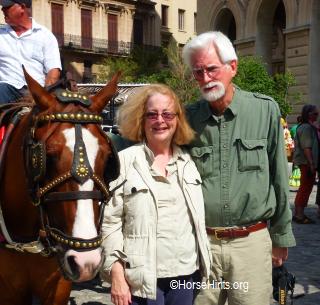
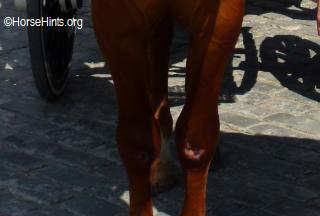 The horse, Peter Pan, pulling our carriage in Cuba was wearing blinkers (left). I also noticed that he had, at one point, fallen to his knees. Look at the picture (right) to see that both Peter Pan's knees are in the healing process from a fall to the knees. Peter Pan's injured right knee is easier to see. However, his left knee was also injured.
The horse, Peter Pan, pulling our carriage in Cuba was wearing blinkers (left). I also noticed that he had, at one point, fallen to his knees. Look at the picture (right) to see that both Peter Pan's knees are in the healing process from a fall to the knees. Peter Pan's injured right knee is easier to see. However, his left knee was also injured.
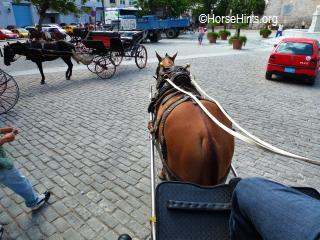
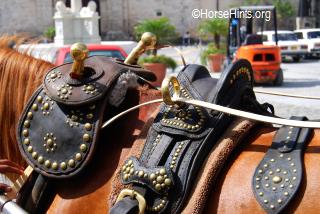
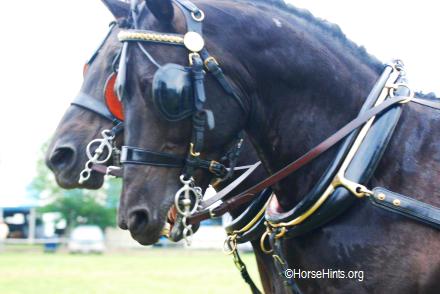 W "Blinders (UK), also known as blinkers (US) are a piece of horse tack that prevent the horse seeing to the rear and, in some cases, to the side. They usually are made of leather or plastic cups that are placed on either side of the eyes, either attached to a bridle or to an independent hood. Blinkers that have a peep hole cut in the back of the cup are known as visors. Many racehorse trainers believe these keep the horse focused on what is in front of him, encouraging him to pay attention to the race rather than other distractions, such as crowds. Additionally, blinkers are commonly seen on driving horses, to keep them from being distracted or spooked, especially on crowded city streets. A 'set of winkers' can refer to the whole bridle, particularly the heavy bridle used on draft horses. ..."
W "Blinders (UK), also known as blinkers (US) are a piece of horse tack that prevent the horse seeing to the rear and, in some cases, to the side. They usually are made of leather or plastic cups that are placed on either side of the eyes, either attached to a bridle or to an independent hood. Blinkers that have a peep hole cut in the back of the cup are known as visors. Many racehorse trainers believe these keep the horse focused on what is in front of him, encouraging him to pay attention to the race rather than other distractions, such as crowds. Additionally, blinkers are commonly seen on driving horses, to keep them from being distracted or spooked, especially on crowded city streets. A 'set of winkers' can refer to the whole bridle, particularly the heavy bridle used on draft horses. ..."
There is a raging debate about "safety of and cruelty to" carriage horses in New York City (Central Park) as well as other places around the USA. There are, as always, proponents and opponents to this debate. As with everything in life there is risk. Below are links to a number of articles discussing this hot topic:
Are Carriage Rides to Cruel to Horses? ![]()
Carriage Horse Controversy Extends Beyond New York City ![]()
Clomping Toward Oblivion ![]()
Almost any horse can be taught to pull a carriage. Remember that there are various kinds of carriages, sulkies and carts. However, as with all things horse, some breeds are much better suited to do so than others. Temperament, willingness, and strength are traits that must be considered when picking a carriage horse. Many breeds are trained to drive. Some of the common draft breeds used for carriage driving include the Percheron, Belgian, Clydesdale and Shire. They are known to be gentle and have a good temperament as well as great strength. These horses are often used when pulling carriages in such places as New York City and other urban areas. Show horses such as Hackney, Andalusian/Lusitano, American Saddlebred, Appaloosa, Arabian, Freisian, Morgan, Paso Fino, paint, pinto, Halfinger, Hanoverian, Holsteiner, Missouri Fox Trotter, Tennessee Walker and other gaited breeds, Thoroughbred and Quarter Horse. Other driving events are overseen by the American Driving Society, which partners with various breed groups. As of 2013, the partnership includes the Andalusian/Lusitano, Connemara, Fjord, Freisian, Haflinger, Gypsy Vanner, Lippizan, Morgan, miniature horse, Shetland, Welsh pony, and the Standardbred through the U.S. Trotting Association. European warmbloods excel in combined driving events. What Kind of Horses Pull Carriages? ![]()
For More Information:
Horse DrivingW Driving (horse)
W Horse Harness
W Horse and Buggy
W Carriage
W Combined Driving